Global Trends in Physical-Activity Research of Autism: Bibliometric Analysis Based on the Web of Science Database (1980–2021)
Abstract
:1. Introduction
2. Materials and Methods
2.1. Data Search Strategy
2.2. Data Analysis and Visualization
3. Results
3.1. Analysis of Document Output
3.2. Analysis of High-Yield Journals and Highly Cited Documents
3.3. Analysis of Major Countries/Regions and Institutions
3.4. Analysis of Main Authors
3.5. Focus and Frontier of PA Research of ASD
3.5.1. Analysis of the Focus Themes
3.5.2. Analysis of the Frontier Topics
4. Discussion
5. Limitations
6. Conclusions
Author Contributions
Funding
Institutional Review Board Statement
Informed Consent Statement
Data Availability Statement
Conflicts of Interest
References
- American Psychiatric Association. Diagnostic and Statistical Manual of Mental Disorders, 5th ed.; American Psychiatric Association: Washington, DC, USA, 2013. [Google Scholar]
- Lotter, V. Epidemiology of Autistic Conditions in Young Children: I. Soc. Psychiatry 1966, 1, 124–135. [Google Scholar] [CrossRef]
- CDC Autism Prevalence Higher in CDC’s ADDM Network. Available online: https://www.cdc.gov/media/releases/2021/p1202-autism.html (accessed on 2 December 2021).
- Maenner, M.J.; Shaw, K.A.; Baio, J. Prevalence of Autism Spectrum Disorder among Children Aged 8 Years—Autism and Developmental Disabilities Monitoring Network, 11 Sites, United States, 2016. MMWR Surveill. Summ. 2020, 69, 1. [Google Scholar] [CrossRef] [PubMed]
- Must, A.; Phillips, S.M.; Curtin, C.; Anderson, S.E.; Maslin, M.; Lividini, K.; Bandini, L.G. Comparison of Sedentary Behaviors between Children with Autism Spectrum Disorders and Typically Developing Children. Autism 2014, 18, 376–384. [Google Scholar] [CrossRef] [PubMed] [Green Version]
- Kiley, T.; MacDonald, M.; Menear, K. Physical Activity and Physical Fitness of School-Aged Children and Youth with Autism Spectrum Disorders. Autism Res. Treat. 2014, 2014, 1–6. [Google Scholar] [CrossRef]
- Jansiewicz, E.M.; Goldberg, M.C.; Newschaffer, C.J.; Denckla, M.B.; Landa, R.; Mostofsky, S.H. Motor Signs Distinguish Children with High Functioning Autism and Asperger’s Syndrome from Controls. J. Autism Dev. Disord. 2006, 36, 613–621. [Google Scholar] [CrossRef]
- Baranek, G.T.; Parham, L.D.; Bodfish, J.W. Sensory and Motor Features in Autism: Assessment and Intervention. In Handbook of Autism and Pervasive Developmental Disorders: Assessment, Interventions, and Policy; John Wiley & Sons, Inc.: Hoboken, NJ, USA, 2005; pp. 831–857. [Google Scholar]
- Ament, K.; Mejia, A.; Buhlman, R.; Erklin, S.; Caffo, B.; Mostofsky, S.; Wodka, E. Evidence for Specificity of Motor Impairments in Catching and Balance in Children with Autism. J. Autism Dev. Disord. 2015, 45, 742–751. [Google Scholar] [CrossRef] [Green Version]
- Todd, T. Teaching Motor Skills to Individuals with Autism Spectrum Disorders. J. Phys. Educ. Recreat. Danc. 2012, 83, 32–48. [Google Scholar] [CrossRef]
- Tan, B.W.Z.; Pooley, J.A.; Speelman, C.P. A Meta-Analytic Review of the Efficacy of Physical Exercise Interventions on Cognition in Individuals with Autism Spectrum Disorder and ADHD. J. Autism Dev. Disord. 2016, 46, 3126–3143. [Google Scholar] [CrossRef] [Green Version]
- Sorensen, C.; Zarrett, N. Benefits of Physical Activity for Adolescents with Autism Spectrum Disorders: A Comprehensive Review. Rev. J. Autism Dev. Disord. 2014, 1, 344–353. [Google Scholar] [CrossRef]
- Sowa, M.; Meulenbroek, R. Effects of Physical Exercise on Autism Spectrum Disorders: A Meta-Analysis. Res. Autism Spectr. Disord. 2012, 6, 46–57. [Google Scholar] [CrossRef]
- Healy, S.; Nacario, A.; Braithwaite, R.E.; Hopper, C. The Effect of Physical Activity Interventions on Youth with Autism Spectrum Disorder: A Meta-Analysis. Autism Res. 2018, 11, 818–833. [Google Scholar] [CrossRef]
- Colombo-Dougovito, A.M.; Blagrave, A.J.; Healy, S. A Grounded Theory of Adoption and Maintenance of Physical Activity among Autistic Adults. Autism 2020, 25, 627–641. [Google Scholar] [CrossRef]
- Yarımkaya, E.; Esentürk, O.K. Promoting Physical Activity for Children with Autism Spectrum Disorders during Coronavirus Outbreak: Benefits, Strategies, and Examples. Int. J. Dev. Disabil. 2020, 1–6. [Google Scholar] [CrossRef] [Green Version]
- Tiner, S.; Cunningham, G.B.; Pittman, A. “Physical Activity Is Beneficial to Anyone, Including Those with ASD”: Antecedents of Nurses Recommending Physical Activity for People with Autism Spectrum Disorder. Autism 2021, 25, 576–587. [Google Scholar] [CrossRef]
- Menear, K.S.; Neumeier, W.H. Promoting Physical Activity for Students with Autism Spectrum Disorder: Barriers, Benefits, and Strategies for Success. J. Phys. Educ. Recreat. Danc. 2015, 86, 43–48. [Google Scholar] [CrossRef]
- Scharoun, S.M.; Wright, K.T.; Robertson-Wilson, J.E.; Fletcher, P.C.; Bryden, P.J. Physical Activity in Individuals with Autism Spectrum Disorders (ASD): A Review. In Autism-Paradigms, Recent Research and Clinical Applications; IntechOpen: London, UK, 2017; pp. 301–331. [Google Scholar]
- Aniszewski, E.; Almeida, H.; Alvernaz, A. Benefits of Physical Activity for the Development of Autistic Children. Int. Phys. Med. Rehabil. J. 2020, 5, 79–80. [Google Scholar] [CrossRef]
- Astorino, T.; Baker, J.; Brock, S.; Dalleck, L.; Goulet, E.; Gotshall, R.; Hutchison, A.; Knight-Maloney, M.; Kravitz, L.; Laskin, J. Beneficial Effects of Clinical Exercise Rehabilitation for Children and Adolescents with Autism Spectrum Disorder (ASD). J. Exerc. Physiol. 2012, 15, 71–79. [Google Scholar]
- National Autism Center. National Standards Project Findings and Conclusions; National Autism Center: Randolph, MA, USA, 2009. [Google Scholar]
- Sa’ed, H.Z.; Al-Jabi, S.W. Mapping the Situation of Research on Coronavirus Disease-19 (COVID-19): A Preliminary Bibliometric Analysis during the Early Stage of the Outbreak. BMC Infect. Dis. 2020, 20, 561. [Google Scholar] [CrossRef]
- Morgan, P.P. The Importance of Being Cited. Can. Med. Assoc. J. 1983, 129, 9. [Google Scholar]
- Wang, K.; Duan, W.C.; Duan, Y.J.; Yu, Y.X.; Chen, X.Y.; Xu, Y.H.; Chen, H.H.; Huang, H.Z.; Xiong, B. A Bibliometric Insight of Genetic Factors in ASD: Emerging Trends and New Developments. Brain Sci. 2021, 11, 33. [Google Scholar] [CrossRef]
- Perez-Vazquez, E.; Lorenzo, G.; Lledo, A.; Lorenzo-Lledo, A. Evolution and Identification from a Bibliometric Perspective of the Use of Robots in the Intervention of Children with ASD. Technol. Knowl. Learn. 2020, 25, 83–114. [Google Scholar] [CrossRef]
- Garcia, S.A. Educational Research on Autism Spectrum Disorders: A Bibliometric Analysis. Bordon-Rev. Pedagog. 2021, 73, 11–31. [Google Scholar] [CrossRef]
- Carmona-Serrano, N.; Lopez-Belmonte, J.; Lopez-Nunez, J.A.; Moreno-Guerrero, A.J. Trends in Autism Research in the Field of Education in Web of Science: A Bibliometric Study. Brain Sci. 2020, 10, 1018. [Google Scholar] [CrossRef]
- Shekarro, M.; Fazeli-Varzaneh, M.; Kuravackel, G.M. A Bibliometric Analysis of Executive Functions in Autism Spectrum Disorder. Curr. Psychol. 2021, 1–14. [Google Scholar] [CrossRef]
- Lorenzo, G.; Lorenzo-Lledo, A.; Carreres, A.L.; Perez-Vazquez, E. Approach from a Bibliometric Perspective of the Educational Application of Virtual Reality in People with Autism Spectrum Disorder. Educ. Knowl. Soc. 2020, 21. [Google Scholar] [CrossRef]
- Sweileh, W.M.; Al-Jabi, S.W.; Sawalha, A.F.; Zyoud, S.H. Bibliometric Profile of the Global Scientific Research on Autism Spectrum Disorders. Springerplus 2016, 5, 1480. [Google Scholar] [CrossRef] [Green Version]
- Sweileh, W.M. Research Trends on Human Trafficking: A Bibliometric Analysis Using Scopus Database. Global. Health 2018, 14, 106. [Google Scholar] [CrossRef]
- Chan, J.S.Y.; Deng, K.; Yan, J.H. The Effectiveness of Physical Activity Interventions on Communication and Social Functioning in Autistic Children and Adolescents: A Meta-Analysis of Controlled Trials. Autism 2021, 25, 874–886. [Google Scholar] [CrossRef]
- Memon, A.R.; Vandelanotte, C.; Olds, T.; Duncan, M.J.; Vincent, G.E. Research Combining Physical Activity and Sleep: A Bibliometric Analysis. Percept. Mot. Skills 2020, 127, 154–181. [Google Scholar] [CrossRef]
- Xu, X.; Mishra, G.D.; Jones, M. Mapping the Global Research Landscape and Knowledge Gaps on Multimorbidity: A Bibliometric Study. J. Glob. Health 2017, 7, 010414. [Google Scholar] [CrossRef]
- Ghadimi, P.; Wang, C.; Lim, M.K. Sustainable Supply Chain Modeling and Analysis: Past Debate, Present Problems and Future Challenges. Resour. Conserv. Recycl. 2019, 140, 72–84. [Google Scholar] [CrossRef]
- Wang, C.; Lim, M.K.; Zhao, L.; Tseng, M.-L.; Chien, C.-F.; Lev, B. The Evolution of Omega-The International Journal of Management Science over the Past 40 Years: A Bibliometric Overview. Omega 2020, 93, 102098. [Google Scholar] [CrossRef]
- Cobo, M.J.; López-Herrera, A.G.; Herrera-Viedma, E.; Herrera, F. An Approach for Detecting, Quantifying, and Visualizing the Evolution of a Research Field: A Practical Application to the Fuzzy Sets Theory Field. J. Informetr. 2011, 5, 146–166. [Google Scholar] [CrossRef]
- Van Eck, N.J.; Waltman, L. Software Survey: VOSviewer, a Computer Program for Bibliometric Mapping. Scientometrics 2010, 84, 523–538. [Google Scholar] [CrossRef] [Green Version]
- Aria, M.; Cuccurullo, C. Bibliometrix: An R-Tool for Comprehensive Science Mapping Analysis. J. Informetr. 2017, 11, 959–975. [Google Scholar] [CrossRef]
- Brookes, B.C. Bradford’s Law and the Bibliography of Science. Nature 1969, 224, 953–956. [Google Scholar] [CrossRef]
- Desai, N.; Veras, L.; Gosain, A. Using Bradford’s Law of Scattering to Identify the Core Journals of Pediatric Surgery. J. Surg. Res. 2018, 229, 90–95. [Google Scholar] [CrossRef]
- Lang, R.; Koegel, L.K.; Ashbaugh, K.; Regester, A.; Ence, W.; Smith, W. Physical Exercise and Individuals with Autism Spectrum Disorders: A Systematic Review. Res. Autism Spectr. Disord. 2010, 4, 565–576. [Google Scholar] [CrossRef]
- Pan, C.-Y.; Frey, G.C. Physical Activity Patterns in Youth with Autism Spectrum Disorders. J. Autism Dev. Disord. 2006, 36, 597–606. [Google Scholar] [CrossRef]
- Srinivasan, S.M.; Pescatello, L.S.; Bhat, A.N. Current Perspectives on Physical Activity and Exercise Recommendations for Children and Adolescents with Autism Spectrum Disorders. Phys. Ther. 2014, 94, 875–889. [Google Scholar] [CrossRef] [Green Version]
- Obrusnikova, I.; Cavalier, A.R. Perceived Barriers and Facilitators of Participation in After-School Physical Activity by Children with Autism Spectrum Disorders. J. Dev. Phys. Disabil. 2011, 23, 195–211. [Google Scholar] [CrossRef]
- Bandini, L.G.; Gleason, J.; Curtin, C.; Lividini, K.; Anderson, S.E.; Cermak, S.A.; Maslin, M.; Must, A. Comparison of Physical Activity between Children with Autism Spectrum Disorders and Typically Developing Children. Autism 2013, 17, 44–54. [Google Scholar] [CrossRef] [Green Version]
- Pan, C.-Y. Effects of Water Exercise Swimming Program on Aquatic Skills and Social Behaviors in Children with Autism Spectrum Disorders. Autism 2010, 14, 9–28. [Google Scholar] [CrossRef]
- Hinckson, E.A.; Dickinson, A.; Water, T.; Sands, M.; Penman, L. Physical Activity, Dietary Habits and Overall Health in Overweight and Obese Children and Youth with Intellectual Disability or Autism. Res. Dev. Disabil. 2013, 34, 1170–1178. [Google Scholar] [CrossRef]
- Kern, L.; Koegel, R.L.; Dunlap, G. The Influence of Vigorous versus Mild Exercise on Autistic Stereotyped Behaviors. J. Autism Dev. Disord. 1984, 14, 57–67. [Google Scholar] [CrossRef]
- Must, A.; Phillips, S.M.; Carol, C.; Bandini, L.G. Barriers to Physical Activity in Children with Autism Spectrum Disorders: Relationship to Physical Activity and Screen Time. J. Phys. Act. Health 2015, 12, 529. [Google Scholar] [CrossRef] [Green Version]
- Watters, R.G.; Watters, W.E. Decreasing Self-Stimulatory Behavior with Physical Exercise in a Group of Autistic Boys. J. Autism Dev. Disord. 1980, 10, 379–387. [Google Scholar] [CrossRef]
- Tse, A.C.Y. Brief Report: Impact of a Physical Exercise Intervention on Emotion Regulation and Behavioral Functioning in Children with Autism Spectrum Disorder. J. Autism Dev. Disord. 2020, 50, 4191–4198. [Google Scholar] [CrossRef]
- Ketcheson, L.; Hauck, J.; Ulrich, D. The Effects of an Early Motor Skill Intervention on Motor Skills, Levels of Physical Activity, and Socialization in Young Children with Autism Spectrum Disorder: A Pilot Study. Autism 2017, 21, 481–492. [Google Scholar] [CrossRef]
- Rafiei Milajerdi, H.; Sheikh, M.; Najafabadi, M.G.; Saghaei, B.; Naghdi, N.; Dewey, D. The Effects of Physical Activity and Exergaming on Motor Skills and Executive Functions in Children with Autism Spectrum Disorder. Games Health J. 2021, 10, 33–42. [Google Scholar] [CrossRef]
- Hilton, C.; Ratcliff, K.; Collins, D.; Jones, J. Physiological and Cognitive Effects of Daily Exercise on Adolescents with Autism Spectrum Disorders (ASD). Am. J. Occup. Ther. 2020, 74. [Google Scholar] [CrossRef]
- Tse, C.Y.A.; Lee, H.P.; Chan, K.S.K.; Edgar, V.B.; Wilkinson-Smith, A.; Lai, W.H.E. Examining the Impact of Physical Activity on Sleep Quality and Executive Functions in Children with Autism Spectrum Disorder: A Randomized Controlled Trial. Autism 2019, 23, 1699–1710. [Google Scholar] [CrossRef] [PubMed]
- Stavrou, K.; Tsimaras, V.; Alevriadou, A.; Gregoriadis, A. The Effect of an Exercise Program on Communication and Behavior of a Child with Autism Spectrum Disorder. Pedagog. Psychol. Med -Biol. Probl. Phys. Train. Sport. 2018, 22, 99–106. [Google Scholar] [CrossRef] [Green Version]
- Pan, C.-Y.; Chu, C.-H.; Tsai, C.-L.; Sung, M.-C.; Huang, C.-Y.; Ma, W.-Y. The Impacts of Physical Activity Intervention on Physical and Cognitive Outcomes in Children with Autism Spectrum Disorder. Autism 2017, 21, 190–202. [Google Scholar] [CrossRef] [PubMed]
- Rosenthal-Malek, A.; Mitchell, S. Brief Report: The Effects of Exercise on the Self-Stimulatory Behaviors and Positive Responding of Adolescents with Autism. J. Autism Dev. Disord. 1997, 27, 193–202. [Google Scholar] [CrossRef] [PubMed]
- Kunzi, K. Improving Social Skills of Adults with Autism Spectrum Disorder Through Physical Activity, Sports, and Games: A Review of the Literature. Adultspan J. 2015, 14, 100–113. [Google Scholar] [CrossRef]
- Huang, J.; Du, C.; Liu, J.; Tan, G. Meta-Analysis on Intervention Effects of Physical Activities on Children and Adolescents with Autism. Int. J. Environ. Res. Public Health 2020, 17, 1950. [Google Scholar] [CrossRef] [Green Version]
- Ayvazoglu, N.R.; Kozub, F.M.; Butera, G.; Murray, M.J. Determinants and Challenges in Physical Activity Participation in Families with Children with High Functioning Autism Spectrum Disorders from a Family Systems Perspective. Res. Dev. Disabil. 2015, 47, 93–105. [Google Scholar] [CrossRef]
- Obrusnikova, I.; Miccinello, D.L. Parent Perceptions of Factors Influencing After-School Physical Activity of Children with Autism Spectrum Disorders. Adapt. Phys. Act. Q. 2012, 29, 63–80. [Google Scholar] [CrossRef]
- Pan, C.-Y.; Tsai, C.-L.; Chu, C.-H.; Hsieh, K.-W. Physical Activity and Self-Determined Motivation of Adolescents with and without Autism Spectrum Disorders in Inclusive Physical Education. Res. Autism Spectr. Disord. 2011, 5, 733–741. [Google Scholar] [CrossRef]
- Pan, C.-Y. Age, Social Engagement, and Physical Activity in Children with Autism Spectrum Disorders. Res. Autism Spectr. Disord. 2009, 3, 22–31. [Google Scholar] [CrossRef]
- Pan, C.-Y. Objectively Measured Physical Activity between Children with Autism Spectrum Disorders and Children without Disabilities during Inclusive Recess Settings in Taiwan. J. Autism Dev. Disord. 2008, 38, 1292–1301. [Google Scholar] [CrossRef]
- Pan, C.-Y. School Time Physical Activity of Students with and without Autism Spectrum Disorders during PE and Recess. Adapt. Phys. Act. Q. 2008, 25, 308–321. [Google Scholar] [CrossRef] [Green Version]
- Pan, C.-Y.; Hsu, P.-J.; Chung, I.-C.; Hung, C.-S.; Liu, Y.-J.; Lo, S.-Y. Physical Activity during the Segmented School Day in Adolescents with and without Autism Spectrum Disorders. Res. Autism Spectr. Disord. 2015, 15–16, 21–28. [Google Scholar] [CrossRef]
- MacDonald, M.; Esposito, P.; Ulrich, D. The Physical Activity Patterns of Children with Autism. BMC Res. Notes 2011, 4, 422. [Google Scholar] [CrossRef] [Green Version]
- Pan, C.-Y.; Tsai, C.-L.; Chu, C.-H.; Sung, M.-C.; Ma, W.-Y.; Huang, C.-Y. Objectively Measured Physical Activity and Health-Related Physical Fitness in Secondary School-Aged Male Students with Autism Spectrum Disorders. Phys. Ther. 2016, 96, 511–520. [Google Scholar] [CrossRef] [Green Version]
- Stanish, H.I.; Curtin, C.; Must, A.; Phillips, S.; Maslin, M.; Bandini, L.G. Physical Activity Levels, Frequency, and Type among Adolescents with and without Autism Spectrum Disorder. J. Autism Dev. Disord. 2017, 47, 785–794. [Google Scholar] [CrossRef]
- Yarımkaya, E.; Esentürk, O.K.; İlhan, E.L.; Karasu, N. A WhatsApp-Delivered Intervention to Promote Physical Activity in Young Children with Autism Spectrum Disorder. Int. J. Dev. Disabil. 2021. [Google Scholar] [CrossRef]
- Esentürk, O.K.; Yarımkaya, E. WhatsApp-Based Physical Activity Intervention for Children with Autism Spectrum Disorder during the Novel Coronavirus (COVID-19) Pandemic: A Feasibility Trial. Adapt. Phys. Act. Q. 2021, 38, 569–584. [Google Scholar] [CrossRef]
- Healy, S.; Marchand, G. The Feasibility of Project CHASE: A Facebook-Delivered, Parent-Mediated Physical Activity Intervention for Children with Autism. Int. J. Disabil. Dev. Educ. 2020, 67, 225–242. [Google Scholar] [CrossRef]
- Tomporowski, P.D.; Lambourne, K.; Okumura, M.S. Physical Activity Interventions and Children’s Mental Function: An Introduction and Overview. Prev. Med. 2011, 52, S3–S9. [Google Scholar] [CrossRef] [PubMed] [Green Version]
- Bahrami, F.; Movahedi, A.; Marandi, S.M.; Abedi, A. Kata Techniques Training Consistently Decreases Stereotypy in Children with Autism Spectrum Disorder. Res. Dev. Disabil. 2012, 33, 1183–1193. [Google Scholar] [CrossRef] [PubMed]
- Anderson-Hanley, C.; Tureck, K.; Schneiderman, R.L. Autism and Exergaming: Effects on Repetitive Behaviors and Cognition. Psychol. Res. Behav. Manag. 2011, 4, 129–137. [Google Scholar] [CrossRef] [PubMed] [Green Version]
- Allison, D.B.; Basile, V.C.; MacDonald, R.B. Brief Report: Comparative Effects of Antecedent Exercise and Lorazepam on the Aggressive Behavior of an Autistic Man. J. Autism Dev. Disord. 1991, 21, 89–94. [Google Scholar] [CrossRef]
- Reid, P.D.; Factor, D.C.; Freeman, N.L.; Sherman, J. The Effects of Physical Exercise on Three Autistic and Developmentally Disordered Adolescents. Ther. Recreat. J. 1988, 22, 47–56. [Google Scholar]
- Park, E.-Y.; Kim, W.-H.; Blair, K.-S.C. Effectiveness of Interventions Involving Physical Activities for Individuals with Autism Spectrum Disorder: A Meta-Analysis. Educ. Train. Autism Dev. Disabil. 2021, 56, 354–367. [Google Scholar]
- Barki, H.; Rivard, S.; Talbot, J. A Keyword Classification Scheme for IS Research Literature: An Update. Mis. Q. 1993, 17, 209–226. [Google Scholar] [CrossRef]
- WHO. Global Action Plan on Physical Activity 2018–2030: More Active People for a Healthier World; WHO: Geneva, Switzerland, 2018; Volume 28, ISBN 9789241514187. [Google Scholar]
- Martin Ginis, K.A.; Latimer-Cheung, A.E.; West, C.R. Commentary on “The First Global Physical Activity and Sedentary Behavior Guidelines for People Living with Disability”. J. Phys. Act. Health 2021, 18, 348–349. [Google Scholar] [CrossRef]
- Tupou, J.; Waddington, H.; Sigafoos, J. Evaluation of a Brief Teacher Coaching Program for Delivering an Early Intervention Program to Preschoolers with Autism Spectrum Disorder. Infants Young Child. 2020, 33, 259–282. [Google Scholar] [CrossRef]
- Kasilingam, N.; Waddington, H.; Van Der Meer, L. Early Intervention for Children with Autism Spectrum Disorder in New Zealand: What Children Get and What Parents Want. Int. J. Disabil. Dev. Educ. 2021, 68, 521–537. [Google Scholar] [CrossRef]
- Qiu, S.; Lu, Y.; Li, Y.; Shi, J.; Cui, H.; Gu, Y.; Li, Y.; Zhong, W.; Zhu, X.; Liu, Y. Prevalence of Autism Spectrum Disorder in Asia: A Systematic Review and Meta-Analysis. Psychiatry Res. 2020, 284, 112679. [Google Scholar] [CrossRef]
- Jones, R.A.; Downing, K.; Rinehart, N.J.; Barnett, L.M.; May, T.; McGillivray, J.A.; Papadopoulos, N.V.; Skouteris, H.; Timperio, A.; Hinkley, T. Physical Activity, Sedentary Behavior and Their Correlates in Children with Autism Spectrum Disorder: A Systematic Review. PLoS ONE 2017, 12, e0172482. [Google Scholar] [CrossRef]
- Healy, S.; Aigner, C.J.; Haegele, J.A.; Patterson, F. Meeting the 24-hr Movement Guidelines: An Update on US Youth with Autism Spectrum Disorder from the 2016 National Survey of Children’s Health. Autism Res. 2019, 12, 941–951. [Google Scholar] [CrossRef]
- Simpson, K.; Adams, D.; Bruck, S.; Keen, D. Investigating the Participation of Children on the Autism Spectrum across Home, School, and Community: A Longitudinal Study. Child. Care. Health Dev. 2019, 45, 681–687. [Google Scholar] [CrossRef]


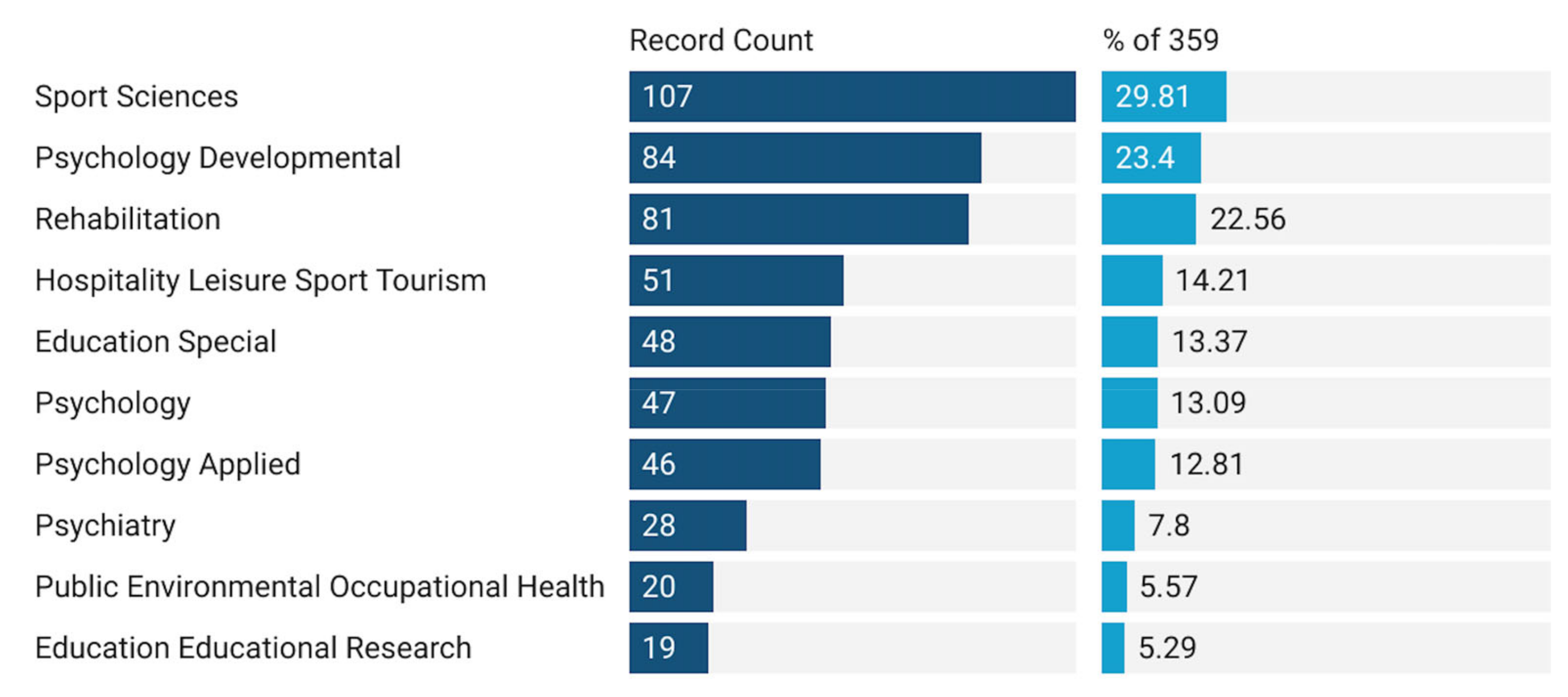

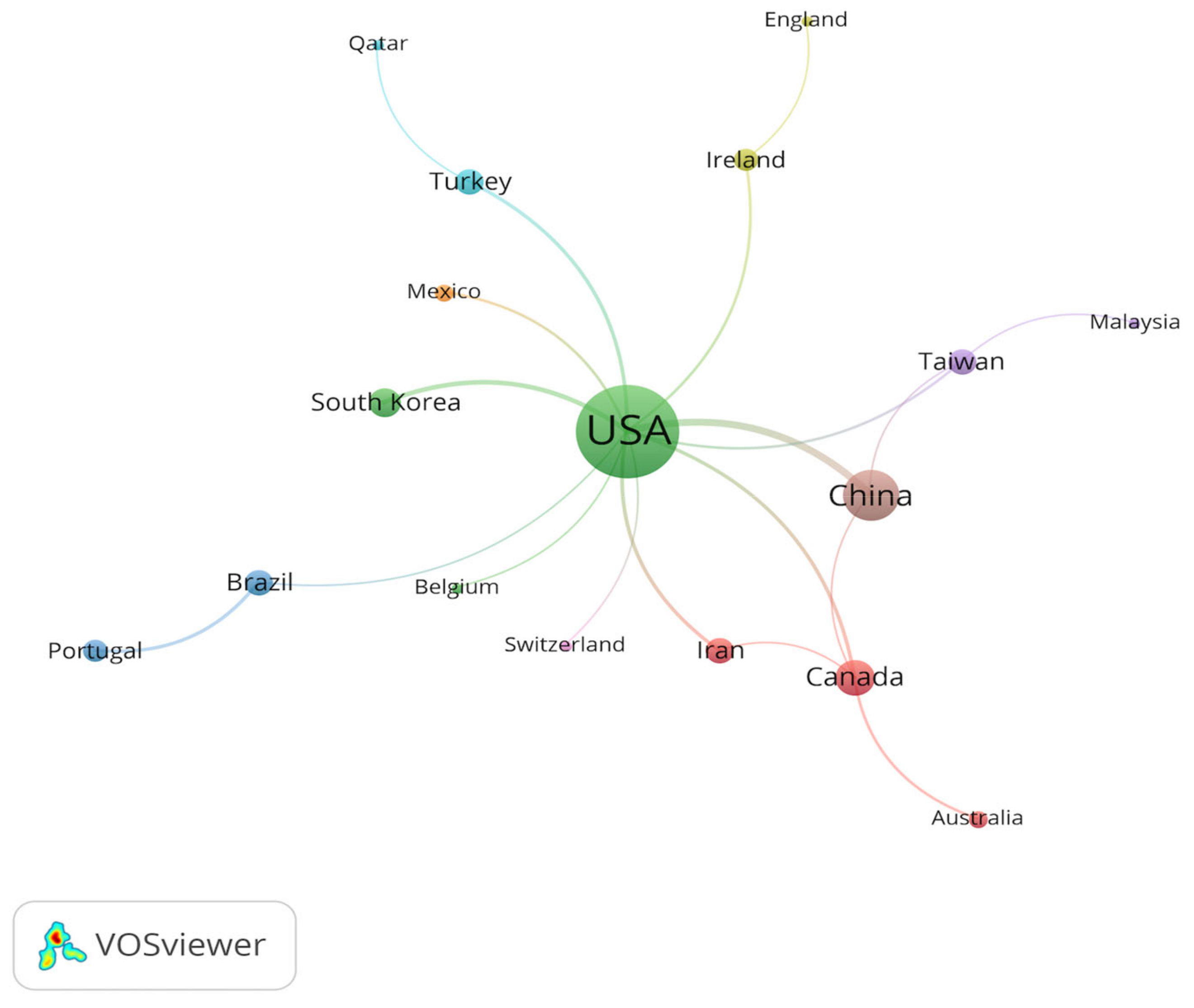
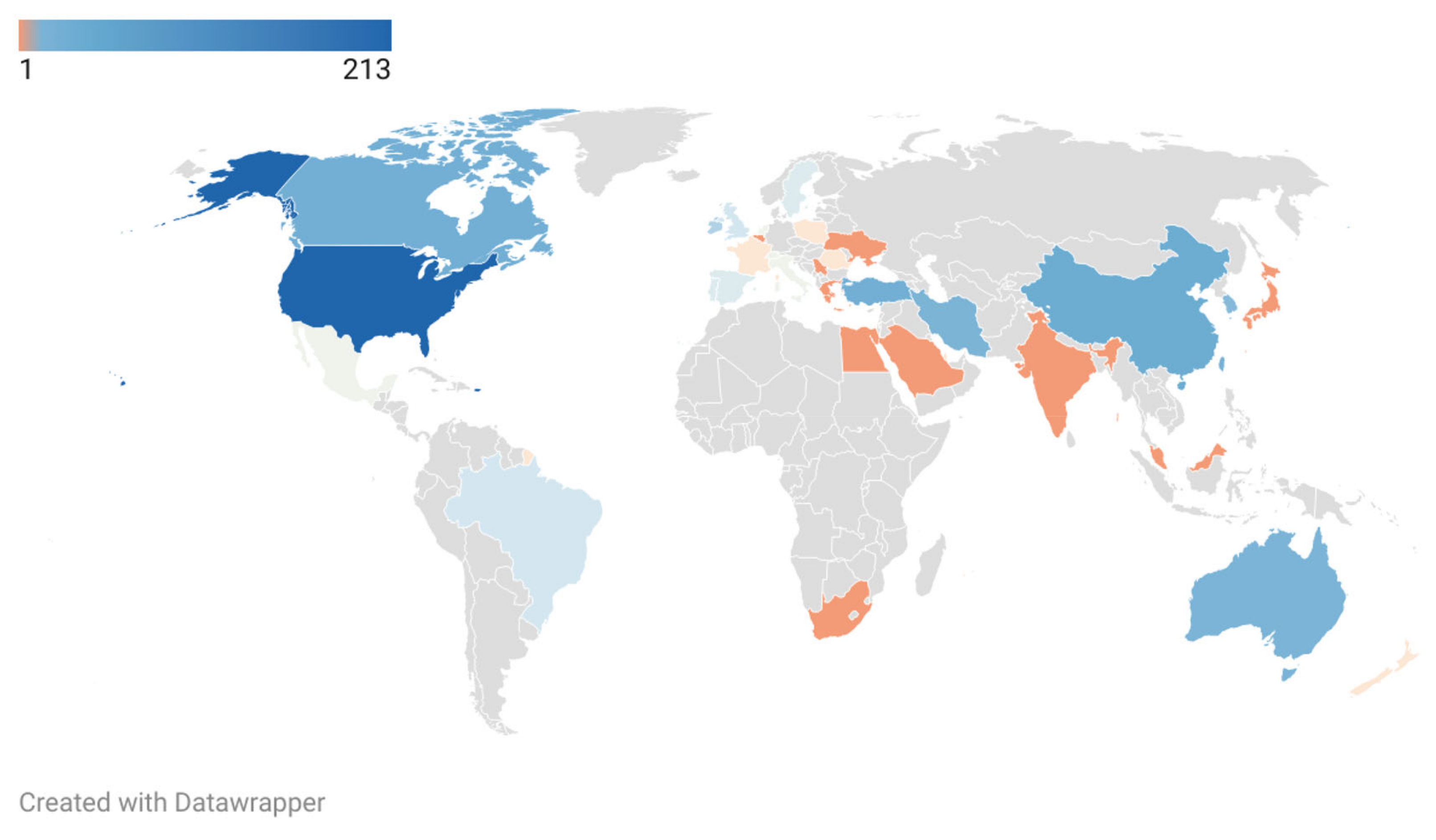

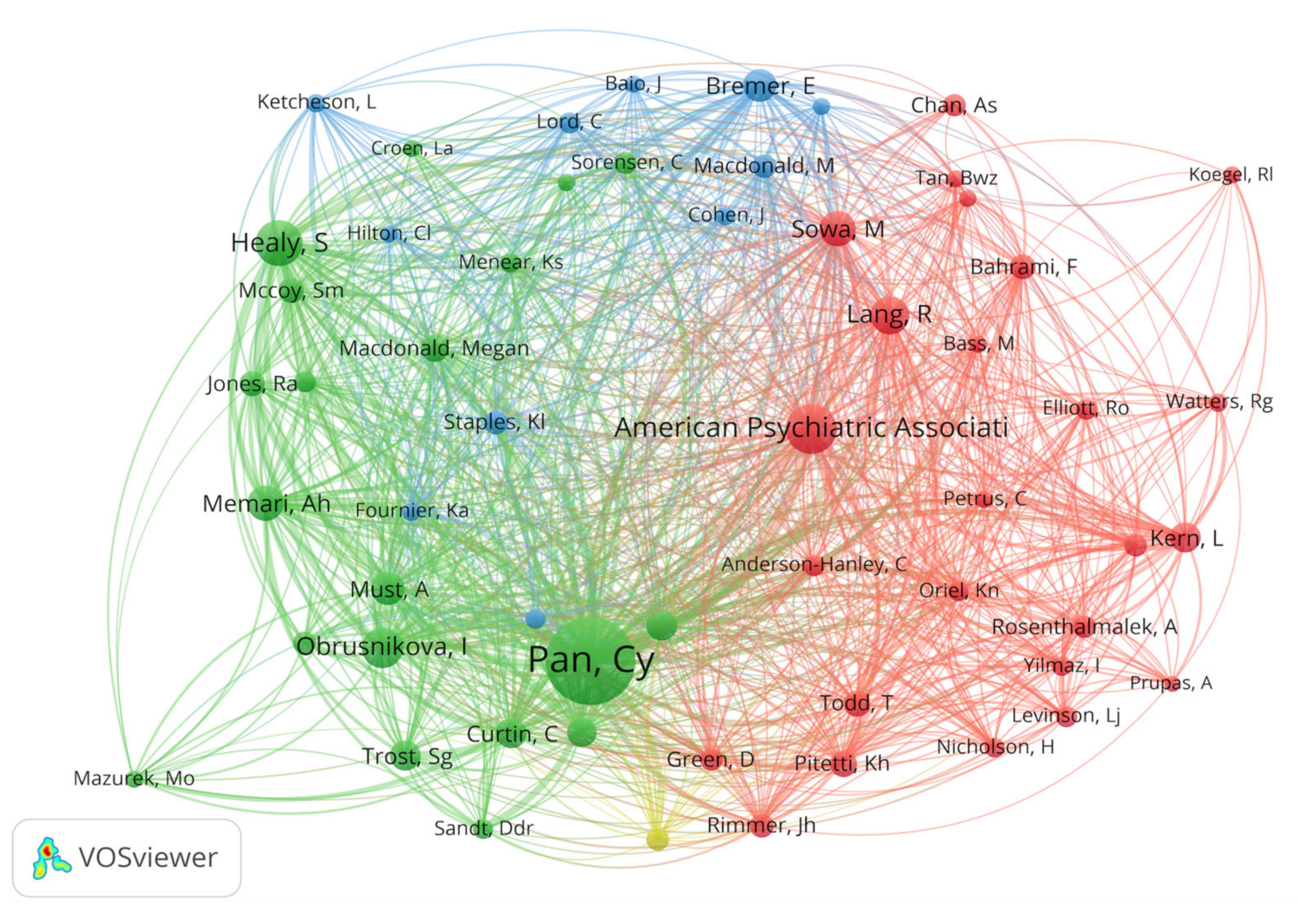
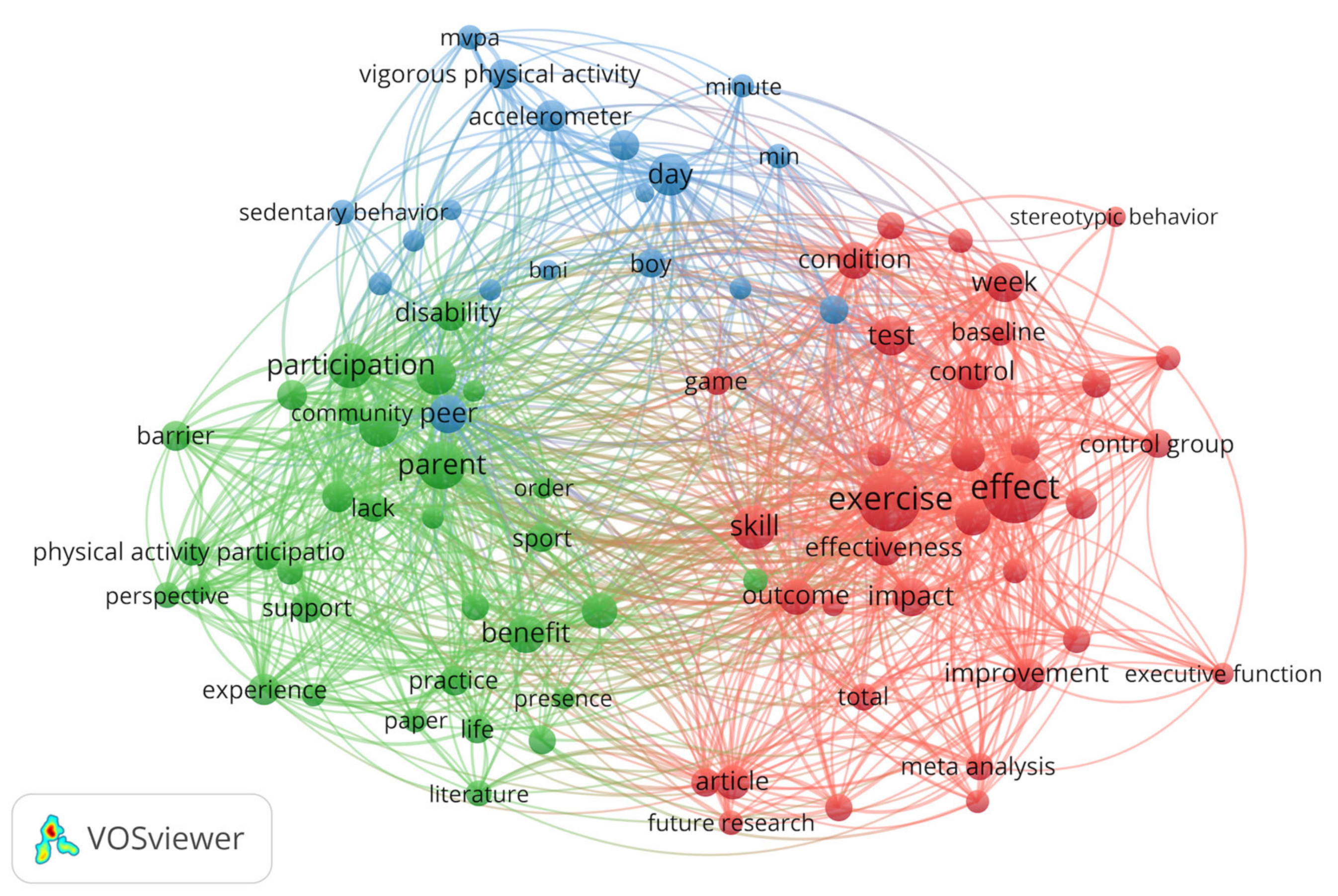
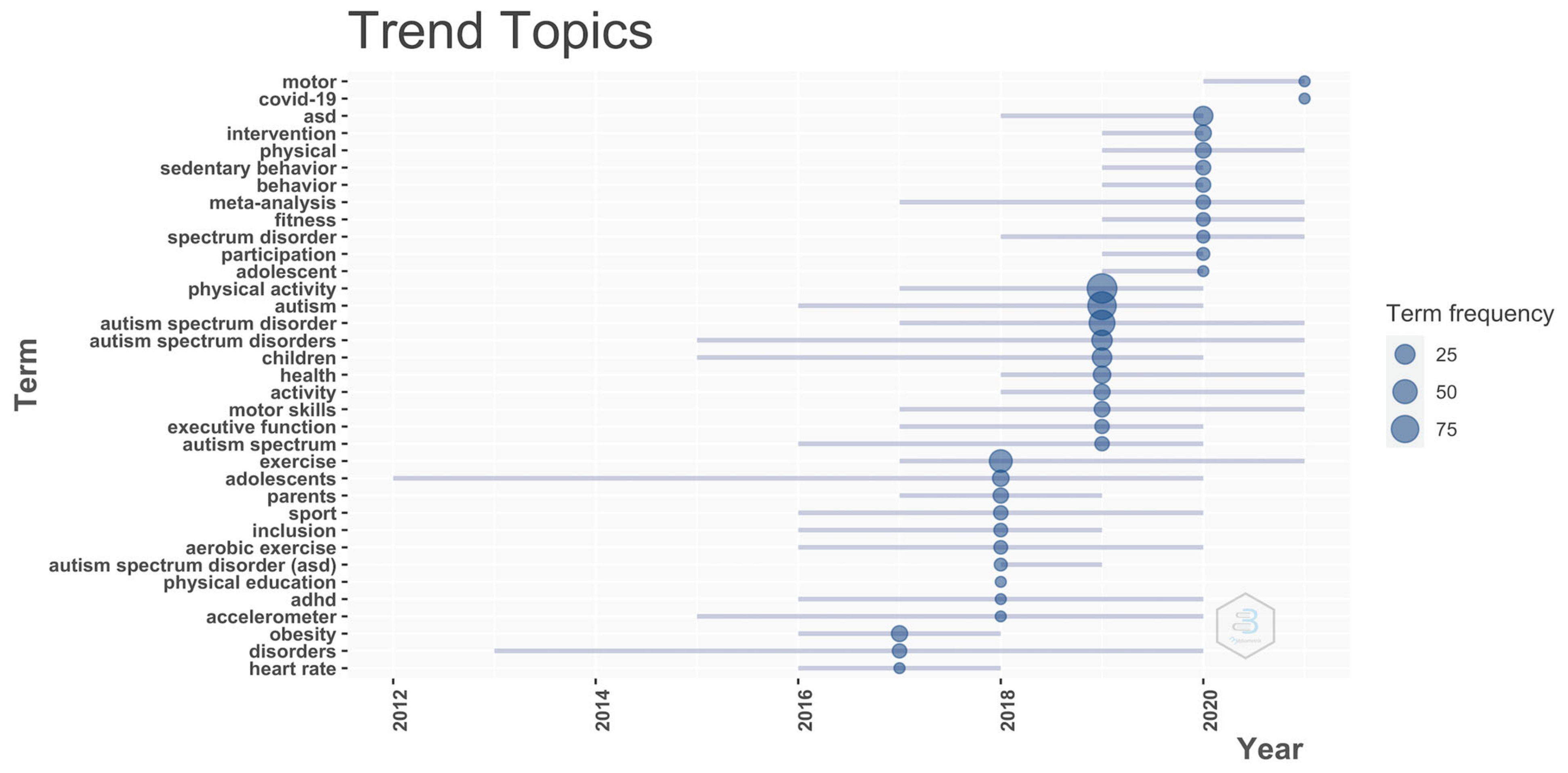
| DT | Count * | TC | CPD |
|---|---|---|---|
| Article | 217 | 3839 | 17.69 |
| Meeting Abstracts | 93 | 9 | 0.1 |
| Review Articles | 33 | 836 | 25.33 |
| Early Access | 16 | 56 | 3.5 |
| Editorial Materials | 6 | 127 | 21.17 |
| Proceedings Papers | 4 | 34 | 8.5 |
| Letters | 3 | 7 | 2.33 |
| Corrections | 2 | 0 | 0 |
| Book Chapters | 1 | 0 | 0 |
| Book Reviews | 1 | 0 | 0 |
| Journal | Published Number (%) | IF 2020 | SJR 2020 | JCR | Categories |
|---|---|---|---|---|---|
| Medicine and Science in Sports and Exercise | 37 (10.306%) | 5.411 | 1.703 | Q1 | Physical Therapy, Sports Therapy, and Rehabilitation; Orthopedics and Sports Medicine |
| Journal of Autism and Developmental Disorders | 33 (9.192%) | 4.291 | 1.374 | Q1 | Developmental and Educational Psychology |
| Research Quarterly for Exercise and Sport | 26 (7.242%) | 2.5 | 0.793 | Q2 | Physical Therapy, Sports Therapy, and Rehabilitation; Orthopedics and Sports Medicine |
| Autism | 17 (4.735%) | 5.689 | 1.899 | Q1 | Developmental and Educational Psychology |
| Journal of Sport and Exercise Psychology | 17 (4.735%) | 3.016 | 0.908 | Q2 | Applied Psychology |
| Palaestra | 13 (3.621%) | NA | NA | NA | Education and Educational Research |
| Research in Autism Spectrum Disorders | 13 (3.621%) | 2.881 | 1.040 | Q2 | Developmental and Educational Psychology Clinical Psychology |
| Adapted Physical Activity Quarterly | 9 (2.507%) | 2.929 | 0.618 | Q2 | Physical Therapy, Sports Therapy, and Rehabilitation |
| International Journal of Developmental Disabilities | 9 (2.507%) | 0.973 | 0.311 | Q3 | Psychiatry and Mental Health; Developmental and Educational Psychology |
| Research in Developmental Disabilities | 6 (1.671%) | 3.23 | 1.024 | Q1 | Developmental and Educational Psychology; Clinical Psychology |
| TC | Article Title | Journal | Published Year | Country/ Region | IF 2020 | JCR |
|---|---|---|---|---|---|---|
| 208 | Physical exercise and individuals with autism spectrum disorders: A systematic review [43] | Research in Autism Spectrum Disorders | 2010 | USA | 2.881 | Q2 |
| 157 | Effects of physical exercise on autism spectrum disorders: A meta-analysis[13] | Research in Autism Spectrum Disorders | 2012 | Netherlands | 2.881 | Q2 |
| 148 | Physical activity patterns in youth with autism spectrum disorders [44] | Journal of Autism and Developmental Disorders | 2006 | Taiwan | 4.291 | Q1 |
| 126 | Current perspectives on physical activity and exercise recommendations for children and adolescents with autism spectrum disorders [45] | Physical Therapy | 2014 | USA | 3.021 | Q1 |
| 114 | Perceived barriers and facilitators of participation in after-School physical activity by children with autism spectrum disorders [46] | Journal of Developmental and Physical Disabilities | 2011 | USA | 1.71 | Q3 |
| 107 | Comparison of physical activity between children with autism spectrum disorders and typically developing children [47] | Autism | 2013 | USA | 5.689 | Q1 |
| 103 | Effects of water exercise swimming program on aquatic skills and social behaviors in children with autism spectrum disorders [48] | Autism | 2010 | Taiwan | 5.689 | Q1 |
| 102 | Physical activity, dietary habits and overall health in overweight and obese children and youth with intellectual disability or autism [49] | Research in Developmental Disabilities | 2013 | New Zealand | 3.23 | Q1 |
| 99 | The influence of vigorous versus mild exercise on autistic stereotyped behaviors [50] | Journal of Autism and Developmental Disorders | 1984 | USA | 4.291 | Q1 |
| 95 | Barriers to physical activity in children with autism spectrum disorders: Relationship to physical activity and screen Time [51] | Journal of Physical Activity & Health | 2015 | USA | 2.592 | Q2 |
| Country/ Region | Articles | TC | H-Index | CPD | Top Country/Region Institutions 1 | Top Institution Articles (%) |
|---|---|---|---|---|---|---|
| USA | 213 | 3129 | 31 | 14.69 | California State University System | 24 (11.268%) |
| China | 33 | 194 | 9 | 5.88 | Chinese University of Hong Kong | 8 (24.242%) |
| Turkey | 25 | 103 | 4 | 4.12 | Anadolu University; Erzincan Binali Yildirim University | 5 (20.000%) |
| Canada | 25 | 363 | 9 | 14.52 | University of Toronto | 7 (28.000%) |
| Taiwan | 19 | 648 | 11 | 34.11 | National Kaohsiung Normal University | 18 (94.737%) |
| Australia | 12 | 235 | 7 | 19.58 | Deakin University | 6 (50.000%) |
| Iran | 11 | 158 | 6 | 14.36 | Tehran University of Medical Sciences; University of Tehran | 4 (36.364%) |
| South Korea | 9 | 37 | 3 | 4.11 | Ajou University; Korea University; Kyung Hee University | 3 (33.333%) |
| Ireland | 7 | 2 | 1 | 0.29 | South East Technological University | 4 (57.143%) |
| Brazil | 5 | 55 | 3 | 11 | Universidade Federal de Alagoas; Universidade Federal de Santa Catarina | 4 (80.000%) |
| Author | Articles | TC | H-Index | Country/Region |
|---|---|---|---|---|
| Chien-Yu, Pan | 21 | 645 | 11 | Taiwan |
| Healy, Sean | 15 | 187 | 7 | USA |
| Frey, Georgia C | 11 | 239 | 3 | USA |
| Chia-Liang, Tsai | 10 | 216 | 6 | Taiwan |
| Chia-Hua, Chu | 9 | 169 | 5 | Taiwan |
| Garcia, Jeanette M | 7 | 90 | 4 | USA |
| Haegele, Justin A | 7 | 86 | 4 | USA |
| Ketcheson, Leah | 6 | 91 | 2 | USA |
| Lee, Jihyun | 6 | 14 | 2 | USA |
| Mccoy, Stephanie M | 6 | 101 | 2 | USA |
| Clusters | Cluster Terms (Occurrences ≥ 10) | Themes |
|---|---|---|
| Cluster 1 (Green) | 35 terms: article, autistic child, baseline, change, communication, condition, control, control group, effect, effectiveness, executive function, exercise, exercise intervention, exercise program, future research, game, impact, improvement, meta-analysis, motor skill, outcome, physical exercise, pilot study, positive effect, present study, review, significant improvement, skill, social interaction, stereotypic behavior, systematic review, test, total, treatment, week. | Individual effect |
| Cluster 2 (Red) | 32 terms: autism spectrum, barrier, benefit, challenge, community, disability, experience, factor, family, influence, interview, lack, life, literature, need, obesity, opportunity, order, paper, parent, participation, person, perspective, physical activity participation, practice, practitioner, presence, recommendation, researcher, sport, support, young adult. | Social support |
| Cluster 3 (Blue) | 18 terms: accelerometer, adolescents, bmi, boy, brief report, comparison, day, min, minute, motivation, mvpa, pa level, peer, physical education, sedentary behavior, significant difference, vigorous physical activity, young child. | Activity dose |
Publisher’s Note: MDPI stays neutral with regard to jurisdictional claims in published maps and institutional affiliations. |
© 2022 by the authors. Licensee MDPI, Basel, Switzerland. This article is an open access article distributed under the terms and conditions of the Creative Commons Attribution (CC BY) license (https://creativecommons.org/licenses/by/4.0/).
Share and Cite
Feng, X.-W.; Hadizadeh, M.; Cheong, J.P.G. Global Trends in Physical-Activity Research of Autism: Bibliometric Analysis Based on the Web of Science Database (1980–2021). Int. J. Environ. Res. Public Health 2022, 19, 7278. https://doi.org/10.3390/ijerph19127278
Feng X-W, Hadizadeh M, Cheong JPG. Global Trends in Physical-Activity Research of Autism: Bibliometric Analysis Based on the Web of Science Database (1980–2021). International Journal of Environmental Research and Public Health. 2022; 19(12):7278. https://doi.org/10.3390/ijerph19127278
Chicago/Turabian StyleFeng, Xiao-Wei, Maryam Hadizadeh, and Jadeera Phaik Geok Cheong. 2022. "Global Trends in Physical-Activity Research of Autism: Bibliometric Analysis Based on the Web of Science Database (1980–2021)" International Journal of Environmental Research and Public Health 19, no. 12: 7278. https://doi.org/10.3390/ijerph19127278
APA StyleFeng, X.-W., Hadizadeh, M., & Cheong, J. P. G. (2022). Global Trends in Physical-Activity Research of Autism: Bibliometric Analysis Based on the Web of Science Database (1980–2021). International Journal of Environmental Research and Public Health, 19(12), 7278. https://doi.org/10.3390/ijerph19127278






